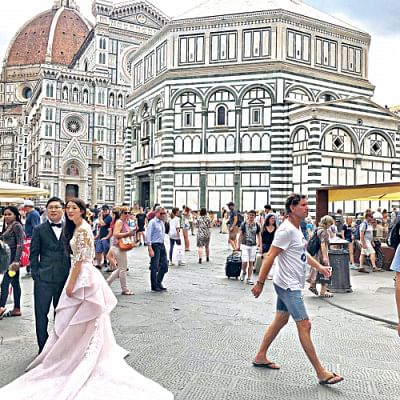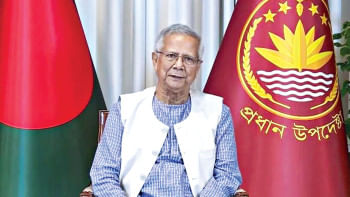Florence spirit of the renaissance

Certain aspects of travel are better left to imagination, but what happened this time threw us off balance.
The flight from London to Pisa, our gateway to Italy, was so smooth that my buddy, with his family on board, slept like a baby. Descent into Pisa opened up lush green pastures sliced by the Arno.
Airport formalities over, we hurried to the on-site shuttle bay, only to find that the shuttle had just malfunctioned. Bummer!

We hopped on a slow airport bus, instead, to get to our intercity bus. Darkness descended fast amid anxiety. Clueless, we circled the airport twice, unsure of where to get off. Hamstrung by language barrier and the weight of our luggage, a stream of sweat ran down my cheek. So little-known was our bus station, and so poor the cellular network, that even a Smartphone didn't help.
My friend, a risk analyst by profession, hunched over a paper map, faced a tough assignment. Sensing our plight, a fellow American, well-versed in Italian, kindly started liaising with the increasingly irritated Italian driver, who had never heard of our nondescript bus stop.
I started doubting my risk-tolerant friend who had made our reservation. Flustered, we got off in the darkness to try our luck and trudged toward a distant light source. Exhausted, we finally got there.
Turned out that it was indeed our bus company. This would be close to a stop on our missed airport shuttle route. Our pounding hearts took a breather, and our sweat streams evaporated as we finally boarded the waiting bus. The ladies even managed to rework their lipsticks.
Leaning back on our seats, relieved, we dreamed of our destination: Firenze, Florence in Italian. My friend tossed his backpack lazily over his seat to an empty one in front. The one-hour bus ride in the dark didn't offer much of a view except for the opportunity to reflect on our innate ability to recover from a risk.
Did the recent events portend trouble ahead?
When we arrived in Florence, early in the morning, the last bird had just retired. A few sodium lights reluctantly stayed on to greet the unappreciative stragglers, woefully unable to arrive at a better time to fall in love with her at first sight.
After disembarking, we were delighted to learn that our hotel was just far enough for a distance runner. Few sighs later, our sprint began in earnest, commando style. I could never imagine running through the dimly-lit unassuming stretch of Florence this early, backpacks on, and suitcase wheels clattering in protest, to the amusement of the locals.
I had driven with a GPS on, but never had I run following a GPS. I instantly appreciated my ability to compete in the Olympics. It was as if the hotel could also leave us on wheels. We finally reached our hotel, panting. Our Florence trip now began. Or did it really?
During check-in, my friend slumped to the floor with everything rapidly darkening around him. Clutching the desk, he announced in an almost inaudible voice, that his backpack containing all their travel documents had opted to part ways with him to relish more Italian road trips. Remember that backpack? Suddenly, the promised comfort of our cosy hotel room seemed miserably distant with pearls of anxiety reappearing on our foreheads. Another piece of good news followed: there was no food available for growling stomachs this early, and all shops had long been closed.
Welcome to Florence where the Renaissance started after Europe was down on its knees! What better place to be down on our knees, hoping for a Renaissance of our own?
Florence, the capital of Tuscany, tucked in the Arno-river valley, is a very pedestrian-friendly walkable city with streets lined with designer shops, restaurants, and grand piazzas. Caressed by the rolling hills, she exudes a sense of optimism. Europe, ravaged by war, with its economy in tatters, found a new direction here in the form of the Renaissance in the 15th century, which dispelled despondency and lifted Europe toward a new vibrant self-worth, led by the human spirit.
The Arno, witness to it all, proudly spins a yarn with her flowing water. This wave of optimism attracted artists, architects, and painters alike to a place where they flourished. World-famous art galleries and museums stand as testaments to Europe's march toward prosperity.
We had reserved well in advance of our timed museum visits to avoid long queues. We were allowed immediate entry to the chagrin of many, saving us precious time.
Uffizi Gallery, a leap from the Gothic to the modern, houses artworks of many renowned Renaissance artists such Leonardo da Vinci, Raphael, and Michelangelo. We were in awe of Leonardo's exquisite paintings, some on wood.
Uffizi overlooks the Arno and the Ponte Vecchio, the famous old bridge reminding us of the link between the old and the new. Once occupied by the farmers, it was now home to sophisticated art dealers and jewellers. An outstanding engineering achievement, this stone bridge was left intact while all others were destroyed.
I got the lure of Academia, boasting one precious piece of exhibit, once inside. The marble statue of David at the centre of the museum, slightly taller than I am, revealed every muscle and vein in a human body in a depiction of youthful beauty and strength. Michelangelohoned his skills by dissecting dead bodies to grasp anatomy, and those skills manifested themselves in the breath-taking statue. David exuded the energy with which a new day dawned.
Then there was her iconic towering Duomo, in Gothic style, with a magnificent dome that set the tone for Europe's revival. The dome, an architectural masterpiece, was designed by Brunelleschi. The unfinished cathedral needed a dome. A challenge was thrown to the public and Brunelleschi won it.
His answer: a freestanding brick structure with curved walls without the use of a wooden frame. This feat, a symbolic stride into a new horizon, combined art with science. Architectural marvel combined with artistic splendour to put Florence firmly in the driver's seat to lead Europe. A young couple getting married at the Duomo sought to etch this spirit of Florence into their new life.
But I'd be remiss if I didn't mention the famous Medici family, whose fingerprints are all over Florence, from the palatial mansions to the exquisite piazzas. They ruled here for generations. Not only did they provide stability, but also commissioned art. Ironically, in later years, David was seen as a symbol of Florentines' struggle against the ruling Medici.
Florence is home to Bistecca Alla Fiorentina, an Italian steak made of veal and sourced entirely from Tuscany. My friend, a foodie, escorted us to a special steakhouse. Different cuts of meat are served together on wooden platters, usually complemented by Chianti wine. It's a large T-bone cut, usually not well done. Florence boasts great gelato chains. Shops specialise in such flavours as crunchy Stracciatella, tangy Amalfi lemon, and even pistachio.
On arrival in Florence, all doors seemed shut in a cruel mockery, but one tiny place, piercing early-morning darkness with its flickering lights, beckoned us.
It was a food stall owned by a Bangladeshi. Their freshly-made hot sandwiches tasted better than the best food I had ever had. When we showed up later at the invitation of the owner to share his untold stories with us, his joie de vivre was palpable.
The stage had been set with our beloved jhalmuri brought in, fused with mustard oil, and affectionately served in newspaper cones. A banquet theatre was set up with stools behind the shop, Dhaka style, exclusively for us. The stories began with initial struggles and hopelessness, and ended with a sense of achievement and unbounded optimism.
Next morning, after a "Cornetto-Eggs Florentine-Pastry-Cappuccino" breakfast at the hotel, I accompanied my dejected, sleep-deprived friend to the station, in search of his lost backpack. He boarded as soon as that bus pulled in and emptied out. Miraculously, the backpack came home with every document intact inside.
Photo: Arif Shahjahan

 For all latest news, follow The Daily Star's Google News channel.
For all latest news, follow The Daily Star's Google News channel. 



Comments